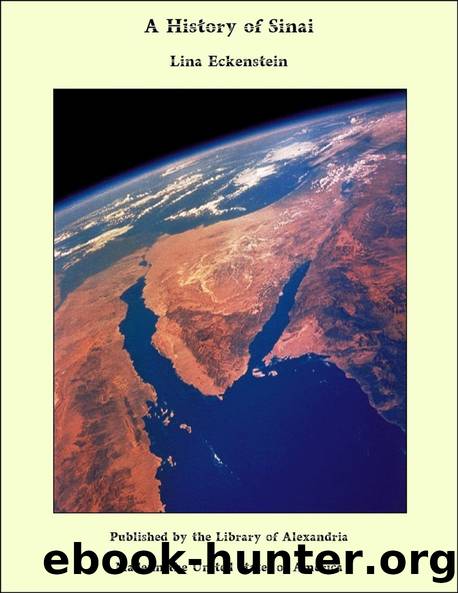A History of Sinai by Lina Eckenstein

Author:Lina Eckenstein [Eckenstein, Lina]
Language: eng
Format: epub
Tags: Nonfiction, New Age, Religion & Spirituality, History, Fiction & Literature
ISBN: 9781465605122
Publisher: Library of Alexandria
Published: 2021-02-24T05:00:00+00:00
The MS. account discovered at Arezzo was incomplete. But the account, in its complete form, was apparently in the hands of Peter the Deacon when he compiled his little book On the Holy Places, about the year 1157, for Guidobaldo, abbot of Monte Cassino. In this book Peter cited passages found in the account that was discovered at Arezzo together with others which seem to be taken from the part of the work which is wanting. In the account which follows, the initial passages are quoted from the book of Peter on the assumption that they were taken from the account of Etheria.
Etheria and her party entered and left Sinai from Egypt.
âBefore you reach the holy Mount Syna, stands the fort Clesma on the Red Sea which the Israelites passed dryshod. The marks (vestigia) of the chariot of the Pharaoh are visible in the ground to this day. But the wheels are farther apart than those of the chariots (currus) of our days as they are seen in the Roman empire, for between wheel and wheel is a space of twenty-four feet or more, and the wheelruts (orbitæ) are two feet wide. These marks of the Pharaohâs chariot lead down to the shore where he entered the sea when he wanted to seize the Israelites. On the spot where the Pharaohâs wheelruts are visible, two signs are set up, one on the right, and one on the left, like little columns (columella).[183]
Orosius (c. 400) in his History of the Universe, also mentioned the marks of the chariot wheels of the Pharaoh, which were still visible.[184] Cosmas Indicopleustes about the year 550 referred to them as âa sign to unbelievers.â[185] The consensus of opinion of these writers suggests the existence of some feature that attracted attention. The word Clysma itself signified beach or jetty. Perhaps the ruts were the marks made by the keels of the boats that were hauled in, in which case the little columns were perhaps the bollards on which the ropes were worked.
âBeyond the place of crossing lay the desert Shur and Mara with its two wells that were sweetened by Moses (probably the Ayun Musa). Three daysâ journey lay Arandara, the place called Helim, where the river, in places, disappeared in the ground and where there was much herbage and many palm trees. From the crossing of the Red Sea near Sur there was no pleasanter place.â The description and the name Arandara point to the present Wadi Gharandel.
Etheria was bent on seeing all the sites, including the place where it rained manna, the cells with Hebrew writing, the desert of Pharan âwhere there were neither fields nor vineyards but water and palm trees,â the place Faran, where Amalek opposed the Israelites, the place where the Israelites called for water, and the place where Jethro met Moses, his son-in-law, âthe spot where Moses prayed while Joshua fought Amalek, is a high, steep mountain above Pharan, and where Moses prayed there is now a churchâ (Petrus, ed. Geyer, p.
Download
This site does not store any files on its server. We only index and link to content provided by other sites. Please contact the content providers to delete copyright contents if any and email us, we'll remove relevant links or contents immediately.
The Daily Stoic by Holiday Ryan & Hanselman Stephen(3263)
The Fate of Rome: Climate, Disease, and the End of an Empire (The Princeton History of the Ancient World) by Kyle Harper(3030)
People of the Earth: An Introduction to World Prehistory by Dr. Brian Fagan & Nadia Durrani(2711)
Ancient Worlds by Michael Scott(2648)
Babylon's Ark by Lawrence Anthony(2646)
The Daily Stoic by Ryan Holiday & Stephen Hanselman(2520)
Foreign Devils on the Silk Road: The Search for the Lost Treasures of Central Asia by Peter Hopkirk(2442)
India's Ancient Past by R.S. Sharma(2432)
MOSES THE EGYPTIAN by Jan Assmann(2393)
The Complete Dead Sea Scrolls in English (7th Edition) (Penguin Classics) by Geza Vermes(2254)
Lost Technologies of Ancient Egypt by Christopher Dunn(2207)
The Earth Chronicles Handbook by Zecharia Sitchin(2202)
24 Hours in Ancient Rome by Philip Matyszak(2064)
Alexander the Great by Philip Freeman(2044)
Aztec by Gary Jennings(1990)
The Nine Waves of Creation by Carl Johan Calleman(1897)
Curse Tablets and Binding Spells from the Ancient World by Gager John G.;(1851)
Before Atlantis by Frank Joseph(1828)
Earthmare: The Lost Book of Wars by Cergat(1806)
